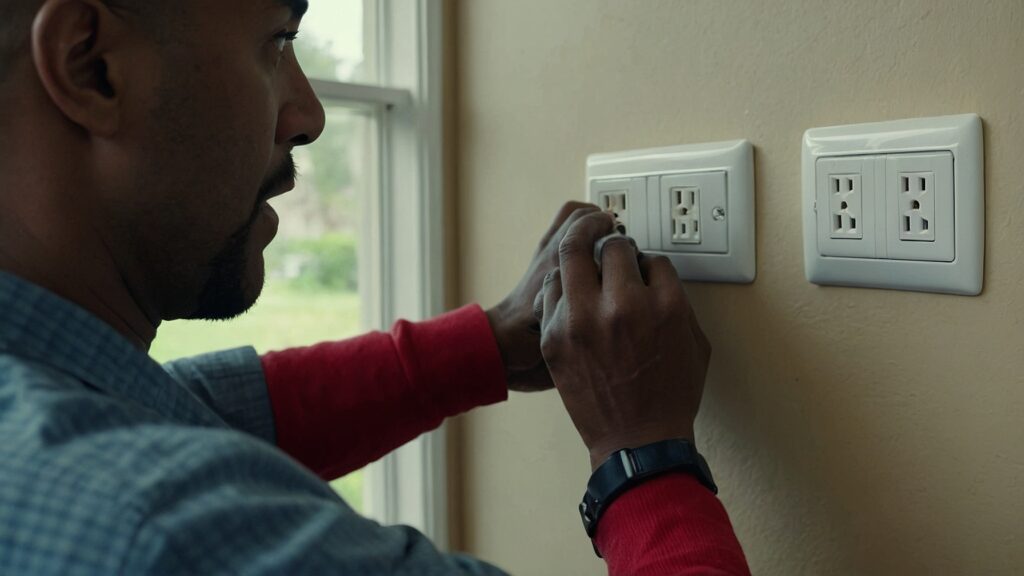Proper outlet spacing in a home ensures that electricity is accessible wherever it’s needed, without overloading circuits or creating hazards. Following the electrical code for power outlets not only keeps your home safe but also makes daily activities more convenient.
For instance, in living areas and bedrooms, placing outlets at least every twelve feet allows for easy access to power for lamps, TVs, and other devices without relying on unsafe extension cords.
Moreover, special areas like kitchens and bathrooms have unique requirements due to the use of appliances that need more power or are used near water. Kitchens require outlets no more than 48 inches apart along countertops to handle multiple appliances safely.
In these critical spaces, correct receptacle spacing becomes even more vital for preventing electrical fires and ensuring that ground-fault circuit interrupter (GFCI) protection can be properly implemented for safety against shock risks.
Electrical Code Requirements for Outlet Spacing
The electrical code outlines specific requirements for outlet spacing in different areas of a home. These guidelines ensure that there are enough outlets to safely and conveniently access electricity throughout the house.
General living areas
In general living areas, outlet placement follows specific guidelines to ensure accessibility and convenience. Every wall longer than two feet requires an electrical outlet. This rule helps avoid the need for extension cords, which can be a safety hazard when used excessively or improperly.
According to residential electrical code requirements, outlets must follow the 6/12 rule: one receptacle within six feet of every wall opening like doors or archways and then no more than twelve feet apart from each other.
Proper outlet spacing in these rooms not only meets building code requirements but enhances electrical safety and functionality throughout the home. Living spaces often host a variety of electronic devices and appliances, from televisions to lamps.
By positioning outlets at least every twelve feet along the floor line, homes comply with household wiring regulations while accommodating modern living needs efficiently.
Bathrooms
When it comes to bathrooms, electrical outlet spacing is crucial for safety and convenience. In bathrooms, outlets must be installed within 36 inches from the edge of a sink basin.
Furthermore, any countertop wider than 12 inches requires an outlet above or on the side of it to ensure accessibility. The National Electrical Code (NEC) stipulates specific requirements for GFCI protection in bathroom outlets to safeguard against electric shock hazards in potentially wet locations.
Bathroom outlet positioning guidelines are essential for ensuring compliance with electrical safety standards and code regulations. Homeowners and construction professionals should adhere to these requirements when planning and installing outlets in bathrooms to maintain proper spacing and height while prioritizing user safety.

Kitchens
In kitchens, electrical outlets need to be positioned no more than 48 inches apart on any wall that is 12 inches wide or more. Additionally, outlets should not be more than 20 inches apart.
These specifications are essential for ensuring convenient access to power sources while using kitchen appliances and devices.
Considering the special requirements for kitchens, it’s crucial to place outlets at optimal distances to support various cooking and food preparation activities. By adhering to these specific spacing guidelines for kitchen outlets, homeowners can ensure a safe and efficient electrical setup in their kitchens.
Factors to Consider for Optimal Outlet Spacing
Consider the amperage of outlet receptacles, ensuring they match the demands of modern electrical devices. Incorporate tamper-resistant and GFCI-protected outlets in areas where increased safety measures are necessary.
Amperage of outlet receptacles
When determining outlet spacing, it is important to consider the amperage of outlet receptacles. Different rooms in a home may require outlets with varying amperages to meet specific electrical needs.
For example, kitchen and laundry room outlets are often required to have higher amperage to accommodate large appliances like refrigerators and washing machines. Understanding the amperage requirements for each area of the home will ensure proper placement and functionality of electrical outlets.
In kitchens, where high-power appliances are common, it’s essential to install 20-amp circuits for countertop receptacles. Additionally, bathroom outlets should be equipped with ground-fault circuit interrupters (GFCIs) due to the proximity of water sources.
Tamper-resistant receptacles
Tamper-resistant receptacles, also known as TRRs, are designed to provide additional safety by preventing children from inserting objects into them. These outlets have built-in shutters that only open when equal pressure is applied simultaneously on both sides.
This is crucial for preventing electrical shocks or burns in homes with young children.
The National Electrical Code (NEC) now requires all newly installed residential and commercial construction to use tamper-resistant receptacles. The NEC states that any location where a code-compliant outlet is required must utilize tamper-resistant receptacles unless there’s an exception such as the installation of a GFCI or AFCI protected outlet.
GFCI protection requirements
When considering outlet spacing requirements, it’s essential to ensure Ground Fault Circuit Interrupter (GFCI) protection in specific locations of the home. According to electrical standards and regulations, GFCI protection is required for outlets located in areas that are potentially exposed to moisture or water, such as bathrooms, kitchens, laundry rooms, and outdoor spaces.
This safety feature helps prevent electrical shocks due to ground faults by quickly cutting off power if a leakage of current is detected. Adhering to these GFCI protection requirements not only ensures compliance with electrical codes but also enhances overall safety within the home.
In bathroom and kitchen settings where water usage is prevalent, the installation of GFCI-protected outlets near sinks and other water sources is necessary. Additionally, outdoor outlets should be equipped with GFCI protection due to exposure to weather elements.
AFCI protection requirements
AFCI protection is essential for home safety according to electrical code regulations. This protection is required in living areas like bedrooms, dens, and home offices. It helps prevent electrical fires by detecting arcs that standard circuit breakers cannot.
Additionally, AFCI protection is mandated for all 15- and 20-ampere branch circuits supplying outlets installed in guest rooms or guest suites of hotels and motels.
Measuring Outlet Spacing
Measure outlet spacing according to the general guidelines. Consider exceptions and special cases, as well as tips for outlet placement.
General guidelines
When determining outlet spacing in a home, the general guideline is to ensure that there is at least one outlet every twelve feet along the floor line. In specific rooms such as kitchens, outlets should be no more than 48 inches apart and cannot exceed 20 inches apart.
Additionally, in general living areas, it is recommended to have an outlet on the wall every 6 feet horizontally. Moreover, according to electrical code requirements, receptacles need to be located within 6 feet from a wall opening and then no more than 12 feet apart after the first one.
These guidelines are crucial for ensuring safe and effective electrical wiring placement in residential spaces.

Exceptions and special cases
In some cases, specific rooms or areas of a home may present unique challenges when it comes to outlet spacing. For instance, areas such as kitchens with limited wall space due to appliances or cabinetry may require special consideration for outlet placement.
In these special cases, homeowners and electricians should pay close attention to the specific requirements outlined by electrical codes in order to ensure safety and compliance. Similarly, bathrooms with wet conditions necessitate different outlet positioning considerations compared to dry living spaces.
To support this, regulations for GFCI protection in bathrooms impact where outlets can be placed within the room. Additionally, rooms with dedicated equipment or heavy power consumption may also have exceptions relating to outlet spacing based on amperage requirements and specialized needs.
Tips for outlet spacing placement
For optimal outlet spacing placement, consider the purpose of each room. In kitchens, outlets cannot be more than 20 inches apart and should not exceed a distance of 48 inches between them along any wall space wider than 12 inches.
It’s also crucial to take into account different requirements for bathrooms, considering GFCI protection needs. When positioning outlets in general living areas, ensure there is an outlet every six feet horizontally to accommodate various appliances and devices used in these spaces.
After understanding the outlet spacing guidelines for different rooms, it’s important to factor in your home’s specific electrical needs when determining the best placement for outlets throughout your living spaces.
Considering these tips can help you optimize safety and convenience while adhering to electrical code regulations.
Conclusion
Proper outlet spacing is crucial for ensuring electrical safety in a home. Understanding the electrical code requirements and factors such as amperage, GFCI protection, and AFCI protection plays a key role in determining optimal outlet placement.
By following guidelines and measuring outlet spacing accurately, homeowners can maintain a safe and compliant electrical system throughout their living spaces.
FAQs
1. What are the rules for how far apart electrical outlets should be in my home?
The guidelines for outlet spacing in a dwelling say that electrical outlets should not be more than 12 feet apart. This rule helps ensure you can plug in appliances anywhere along the wall.
2. Why do we have specific spacing requirements for electrical outlets?
Electrical outlet spacing requirements make sure that electricity is safely and conveniently accessible throughout your home, reducing the need for extension cords and helping to prevent overloading of outlets.
3. Do different rooms have different rules for outlet placement?
Yes, regulations for outlet placement vary by room type. For example, kitchens and bathrooms may require more closely spaced outlets due to the higher number of appliances used in these areas.
4. Is there a code I need to follow when positioning outlets during home construction?
Absolutely! There’s a code for outlet placement that builders must follow to ensure safety and compliance with national standards regarding residential wiring within your home’s electrical system.
5. How does following receptacle spacing regulations benefit me?
By adhering to receptacle spacing regulations, your home’s electrical system will meet safety standards, reduce risks of fire hazards from overloaded circuits, and provide convenient access to power wherever needed in your living areas.